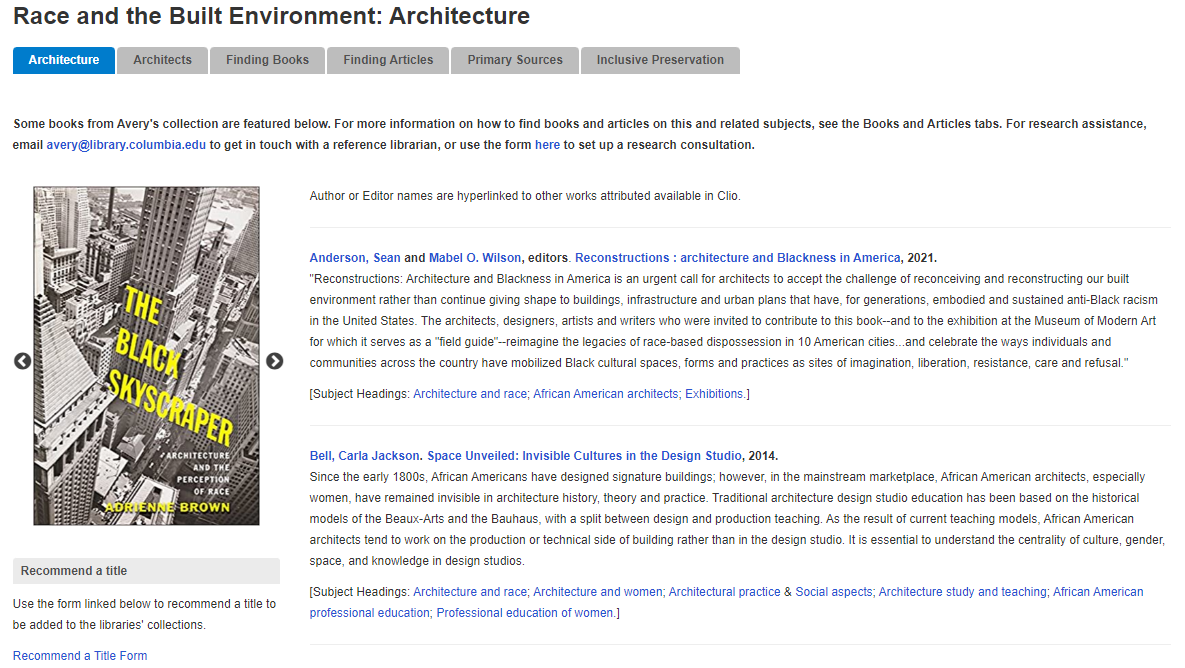
Representation through Resources: Creating a Research Guide to Elevate Marginalized Voices in the Built Environment
Jenny Davis, Public Services Librarian, Avery Architectural & Fine Arts Library
Dylan Rosenlieb, Avery Classics Assistant, Avery Architectural & Fine Arts Library
This column is based on a presentation of the same title given by the authors at the Association of Architecture School Librarians 2022 conference.
Alongside ongoing efforts to diversify collections at Avery Architectural & Fine Arts Library, and in response to student feedback, we created a research guide to help users navigate resources related to race and the built environment. In conversations, students expressed difficulty finding these materials, or finding works by or about BIPOC architects, designers, and urban planners. These comments mainly came from students at Columbia’s Graduate School of Architecture, Planning, and Preservation, but also from researchers in subject areas such as sociology, history, and public policy. It became clear that the issue was not just collection contents, but also how to effectively highlight these important resources already within the library. This guide lives on our library’s homepage for ease of access and is designed to be used with or without real time assistance from a librarian. Primarily, it is utilized as a tool during one-on-one research consultations or library instruction sessions. Importantly, it is intended as a starting point for researchers rather than an encyclopedic collection on the subject. As a living document it continues to be updated and expanded as we receive feedback and find new resources to add.
Our first goal with the research guide was to direct users to resources within the libraries. Our second was to encourage them to think beyond Avery, or Columbia Libraries as a whole. With this in mind, we included links to other research institutions and professional organizations.
The guide is divided into six sections: Architecture, Architects, Finding Books, Finding Articles, Primary Sources, and Inclusive Preservation. Finding Books and Finding Articles gives some general advice about searching the catalog and databases, while the other four sections are more complex.
The Architecture section begins with a short list of books related to race and the built environment. They were identified through subject searches in CLIO, our library catalog, and limited to works published in the last five years in order to highlight recent scholarship. For each title selected, we listed subject headings–controlled vocabulary terms assigned to each book to make them more discoverable–with each heading linked to a subject search in the full catalog. These linked searches help users to find similar material, for example “architecture and race” and “discrimination in housing.” To empower users to help build our collection to match their research needs, each page includes a link to our Recommend a Title For Purchase form, and allows users to be notified when a recommended title is available.
The Architects section offers a compiled list of professional organizations such as the National Organization of Minority Architects, Black Women in Architecture Network and the American Indian Council of Architects and Engineers, with links to local chapters when possible. Sites profiling individual architects, such as the Smithsonian National Museum of African American History and Culture’s “Building a Better Future”, are also included.
The Primary Resources section includes archival collections held at Columbia and beyond, including New York Public Library’s Schomburg Center for Research in Black Culture. This was prompted by conversations with users about the nature of collecting–how a multitude of factors determine where a particular person’s papers are held. In order to provide students with pathways to resources beyond architecture-focused material, we linked to several online newspaper collections, including collections that focus on Black and Native American newspapers. We also included web archives, such as the Ivy Plus CAUSEWAY collection (Collaborative Architecture, Urbanism, and Sustainability Web Archive), and New York City Spaces and Places, which documents the evolution of the built environment and public spaces in and around NYC through the interaction of historic preservation efforts and new development projects within urban planning debates.
The final section, titled Inclusive Preservation, speaks directly to our GSAPP student research needs. Here, we highlight resources that help users think more critically about preservation. We chose to include resources like “The Inclusive Historian’s Handbook” which supports inclusive and equity-focused historical work in public settings- authored by historians and active preservationists. We also included resources published by GSAPP, such as Issues in Preservation Policy.
Our goal is to continuously update this guide as we discover more resources and add new titles to the collection. Our colleagues at Avery, in AASL, and Columbia’s GSAPP have been instrumental in sharing new resources, and have helped us form new ideas of the growth for this research guide.
Questions
Heather Albarazi
Digital Marketing & Communications Manager
202-785-2324
halbarazi@acsa-arch.org

 Study Architecture
Study Architecture  ProPEL
ProPEL 